 Net Inclusion – May 18-19, 2016, Kansas City, MO
Net Inclusion – May 18-19, 2016, Kansas City, MO
There are a lot of links in this material, we encourage you to explore the ones of most interest to you.
Key points:
- It’s an exciting time for digital inclusion.
- Kansas City, Minneapolis and Seattle have a lot of experience with digital inclusion initiatives and can serve as models for other communities.
- There is a great willingness to share experiences, which is helping us all.
- In completing grant applications, refurbishers should stress the case for environmental benefits.
- There are innovative ways to increase knowledge such as the Kansas City library’s bookmarks on how to add an attachment in email.
The National Digital Inclusion Alliance and the Kansas City Public Library welcomed digital inclusion practitioners, advocates, academics, Internet service providers and policymakers to Net Inclusion 2016. The agenda page lists the slides from particular sessions or they can be found here. The attendees included many libraries, non-profits, some vendors, policy-makers and a few refurbishers.
The National Digital Inclusion Summit began with participants choosing between a pre-conference workshop and four tours sponsored by the Gigabit City Summit. Katherine went to the first tour, Barry went to the third.
- Startup Culture and Gigabit Fiber – The group visited the Kauffman Foundation to witness 1 Million Cups, which started in Kansas City and has gone national. The weekly startup session has two local entrepreneurs describe their project to a diverse audience of mentors, advisors and entrepreneurs. They have six minutes to talk followed by twenty minutes of feedback. They learn how to improve their business plan and their presentation while everyone learns from the real-time feedback. A local singer-songwriter performed before the first presentation, leading to a festive atmosphere at nine in the morning. (There was plenty of free coffee available as well.) Since this occurs weekly, many people attend multiple times, building a community. The second stop was the Kansas City Startup Village, where an emerging cluster of startups bought and/or moved into houses in the first Google Fiber neighborhood. It has spawned the Kansas City Startup Foundation to help advocate for startups. The mindset is one of collaboration and mutual support. The goal to have companies outgrow the village while recognizing that not every company will succeed. The guide mentioned that he was going to a failure party for a company that is folding. If people take risks, they don’t always succeed. This tour ended with a stop at the first Google Fiber space, a retail showroom for the company’s home Internet service. Throughout the conference, the phrase, ‘After Google Fiber came to Kansas City,’ was the lead-in to a lot of wonderful things that happened. Connectivity matters.
There were some great displays at the Google Fiber space:
- Digital Inclusion: Connectivity – This tour started at Juniper Gardens public housing in Kansas City, KS, where Connecting for Good has set up a community wireless network and runs a computer technology center. The group then traveled to the Wayne Miner housing development, where Google Fiber is providing free gigabit WiFi as part of ConnectHome. They visited the Center City neighborhood, where Reconciliation Services has added a computer lab to the RS Café, and where the Urban Neighborhood Initiative is piloting a mesh WiFi network to provide free Internet service and network training to residents.
- Digital Inclusion: Literacy and Training – the tour was led by Sarah Bell, a digital literacy fellow at Literacy KC. The first stop was Operation Breakthrough, a program which introduces technology into Early Education and offers STEM training through high school. They are working to expand capacity since they have a long waiting list. The STEM lab update was completed in May, with the first use the week the tour visited. They have a physical media workshop, providing children with stations focused on cooking, building (some young children were working on a project to make lego blocks fly), how things work (taking apart a stereo speaker), and Makerspace (a community space with tools). The second stop was the WEB Dubois Learning Center, which has been providing academic remediation and enrichment since 1973. The learning center occupies a previously shuttered high school and provides tutoring. Classes include reading, math, STEM, computer training, and robotics. They offer college placement services as well as workforce development programs, targeting out-of-school and out-of-work youth ages 16-24. All classes are free. The center operates with a single full-time staff member and many volunteers. They recently launched a radio station. Dr. Deana Ervin stresses “It’s more than the Wi-Fi. It’s about skills.” The third stop was at Surplus Exchange, a non-profit recycling and refurbishing facility which provides computers and office furniture. They also have a retail outlet and work with a recycler in Illinois. They have a “Learn and Earn” program for providing computers to disadvantaged youth.
- Smart City, Living Lab + Streetcar – Kansas City has unveiled its signature downtown collaboration with Cisco, Sprint and many other partners. A 2.2 mile streetcar line opened on May 6, and the city used this construction project to align a number of city assets and smart city technologies along the way. This (mostly) walking tour headed from downtown toward Union Station to get a first-hand look at the CityPost kiosks, the networking hardware on city light poles. They heard about the city’s plans to leverage the enormous amounts of data that will be generated by the project. They also stopped at Think Big Partners, which hosts the KC Living Lab, a commercialization platform for entrepreneurs who want to take advantage of the smart city assets.
Conference
The keynote speaker, Gigi Sohn, Counselor to the Chairman of the Federal Communications Commission, gave interesting and factual information about where broadband connectivity has been and where it is heading. Lifeline had legal and economic issues, but due to recent efforts, millions of Americans will have expanded access. See Barry’s blog post about this topic. It takes verifying out of the providers’ hands to cut down on duplication and waste. There is a review mechanism because they don’t want waiting lists. They streamlined the process to become a Lifeline provider which should decrease prices and increase options. In response to a question about federal agencies working together, Sohn mentioned that the White House has established the Broadband Opportunity Council bringing executive agencies together. The FCC isn’t technically part of that but does participate.
Katherine attended the workshop ‘Integrating Media Justice with Broadband Adoption.’ Accessing media defines and shapes much of people’s lives. Media Justice puts the tools into people’s hands so they can tell their own stories. The panel session included: Media Mobilizing Project, Brown Paper Tickets, Media Democracy Fund, The Utility Reform Network (TURN), Resilient Communities New America and Alliance for Community Media.
Media Justice is a long-term vision to achieve racial equality, not separate from social and economic justice. Beyond digital inclusion and digital literacy, there are the digital justice principles. These include: access, participation, common ownership and healthy community. As one of the panelists said, “Digital justice advances our ability to tell our own stories, as individuals and as communities.” All agreed that freedoms are intertwined. It is hard to have other freedoms without economic freedom.
Barry attended the workshop on Tracking Digital Equity: Measures and Metrics for Programs and Communities. Presenters included representatives of the cities of Seattle and Minneapolis. Both cities have dedicated personnel and plans to address digital inclusion. They can serve as models for other communities addressing these needs. One key takeaway for adoption is to share stories from people with similar backgrounds (cultural, economic).
- Seattle (Vicky Yuki) http://www.seattle.gov/tech/initiatives/digital-equity has been running surveys every four years since 1999 with random telephone interviews, focus groups and on-line surveys. They used the data to launch a digital equity initiative. Details are available from the 2014 report.
- Minneapolis (Otto Doll) http://www.ci.minneapolis.mn.us/it/inclusion/index.htm found there were 90 organizations working with digital inclusion – some very small. They surveyed their citizens, sending out 12000 surveys by mail and receiving 3000 responses. They established a Digital Equity Framework and are working with organizations to ensure that the services they provide are in alignment with the needs. For example, they found that community tech centers were not being used much. They have developed community profiles to identify needs in specific areas such as a neighborhood cluster or ward. In providing technology, Minneapolis has found that the Apple ecosystem has lower maintenance costs and have migrated to this from Windows. The speaker noted that the mission should drive the selection of devices and services.
- Connected Nation (Heather Gate) http://www.connectednation.org/research has been doing studies on Access, Adoption and Use in a variety of states where they operate. They are trying to answer: “are you adopting, and if not, why not?” They are moving from activity numbers to measuring the impact. They work with communities to survey and develop a technology access plan, measuring the impact of the programs.
- Knight School of Communication (Brandon Brooks) http://digitalcharlotte.org/developing-a-digital-inclusion-strategy-for-charlotte/ is working to develop a map of inclusion efforts and sponsor a conference to bring them together. He notes that research can be daunting, and that universities are a good resource since they want the research. He offered to provided connections to find a university willing to help those who were interested.
Katherine attended a workshop on Increasing Digital Equity for Public Housing Residents: ConnectHome and Local Strategies. ConnectHome is a broadband adoption initiative of the U.S. Department of Housing & Urban Development. They have created a platform for public-private collaboration and locally-tailored solutions to narrow the digital divide for HUD-assisted residents and their school age children. It built on ConnectED and the President Obama’s other broadband initiatives. There is a White House Fact sheet on ConnectHome.
The panel included Aaron Wilkins of Human-IT, one of our partners. He discussed how they did outreach for their part of the ConnectHome. It required a lot of calls. They made 3,000 calls to get 1400 people. They had a number of no-shows, but walk-ins made up for that. Once they gave out the equipment, they had lots of calls for support, but many could be fixed via the housing support or the callers figured it out themselves. The partnership with Sprint was great. Lessons learned: ensure the ISP used has good reps and provides good service to the people receiving the devices. Technical support is different for different devices. It’s important to have pre-committed devices to give away.
Cleveland Connects gave away over 200 tablets and wifi. The program is focused on youth who attended after school programs. The program required the child and the parents to sign a pledge before receiving about $300 worth of equipment.
Common Sense Media provides advice to parents and educators about media. They are involved nationally with ConnectHome. Getting devices can be a challenge. The speaker recommends sustainability via federal/state appropriations. He also recommends a ‘volunteer corp’ for regular follow-up services with families that are getting equipment.
Barry attended Providing Technology Education for Digital Newcomers: Challenges and Solutions. Ken Charvoz led this session, which was in large part an effort to introduce his http://iconnect247.net platform. Ken has developed computer training courses for OASIS, a licensed platform with 40 courses used by many library systems. iConnect 24/7 is a platform for sharing training material for free. It is a work in progress which contains courses he has developed that range from ‘using a mouse’ through ‘MS Office certification’. Recognizing that software discussed in a course can change literally overnight, his site includes a blog, which he uses to address changes that have not been reflected in the course content. His intent is for the platform to serve as a forum for non-profits to share their training material. He wants everyone to use it as a resource.
Discussion within the group included:
- Literacy is an issue. For many students, reading (or reading in English) is a barrier to learning, and there is a need for some courses (particularly mouse basics and using a browser) to provide training with screenshots and audio, rather than text.
- The structure of training has to support the client base. In some environments, students can attend six weeks of courses, two days a week, and build knowledge and community. In others, courses need to be provided as a single class (1-1.5 hours).
- There is a wealth of on-line training, but in order to encourage/retain students, additional mechanisms are often needed. Two approaches which have yielded success are
- Flipped course where the material is on-line, but a knowledgeable mentor is available during certain hours to help.
- Learning circles, where a group of people take the course simultaneously, and can share experiences and help each other learn. See Peer to Peer University for details, and how this has been working in Chicago libraries.
- Tools recommended:
- Northstar Digital Literacy is a nationally recognized set of certifications which can be used to prove skills to employers.
- There was discussion about browser plug-ins that help a user walk through the steps in a complicated form, giving additional guidance for something complex, like setting up a LinkedIn profile, but nothing specific was shared.
The second day of the conference began with discussing National Digital Inclusion Alliance (NDIA) which includes organizations across the United States. Becoming an affiliate is free, and requires agreement with the principles. Subscribers (including PBDD) pay an annual fee and receive additional benefits. NDIA is a bridge between digital inclusion practitioners and policy makers. All the attendees were at tables and each table worked together on policy priorities for NDIA, then shared their items with the larger group. Barry and Katherine’s table discussed a number of specifics, including:
- If a company/organization requires online submission then the company/organization must help make the Internet available to everyone affected.
- Regulate speed/etc so that the experience is similar for different people.
- Consider taxing the on-line advertising or market budgets of ISP to fund digital equity programs.
Katherine intended to go to the Learning Circles: Offline Learning session, but after signing up at p2pu.org, Peer 2 Peer University, she decided to explore setting one up later. It seems like a worthwhile endeavor with an open source toolkit for running learning circles. P2PU has found a much-higher success rate of people taking online classes in a learning circle instead of on their own.
Instead, she attended Information is Power: Better Broadband Adoption Data. From Pew Research Center – Broadband adoption has gone down from 70 – 67%. Have seen an increase in smartphone usage. Smartphone-only users increased from 8% in 2013 to 13% in 2015. NTIA, National Telecommunications & Information Administration has found that youth and older Americans are using the Internet more.
Barry attended a session on Low Cost Equipment where Jim Lynch of TechSoup provided an industry perspective, a recap of some information he had presented recently at an industry conference. With recent business cycles, he anticipates a large number of PCs coming available for refurbishing soon. He notes that twenty percent of the industry is non-profits, which is quite exceptional compared to most industries. Eighty percent of the market for US-refurbished computers is in the United States with the remaining twenty percent mostly wholesalers. Jim Lynch reported the issues with mobile devices (glued components, including batteries) which are a significant barrier to refurbishing, though he acknowledged that iFixit is providing information, helping identify tools and promoting the right-to-repair movement to address mobile device repair. In addition to assembling repair manuals for a wide variety of devices, iFixit has a put together a set of manuals on how to set up a refurbishing program. Jim noted the trend away from on-premise (machine-hosted) applications and data, with more and more moving to the cloud. With regard to Windows 10, this is expected to be the “last” version of windows, with continual upgrades going forward. He anticipates that Windows 10 will be made available to refurbishers by mid-autumn.
Sam Drong of PCs for People, in Minneapolis, discussed their operation. With the processes they have in place, they have reduced the amount of technician time needed to refurbish a computer to fifteen minutes. They refurbish approximately 8500 computers per year. For the most part, they sell them for $30, $50, or $100 each, based on performance spec, though they do give some away for free. They provide repair service for $25. They also provide technology and connections for access to the Internet. They are working with both Mobile Beacon and Mobile Citizen, organizations which help non-profits provide digital connectivity.
Colleen Dixon of FreeGeek shared that they provide free open source computers and training to individuals in exchange for community service. They also provide computers to non-profit organizations. Most of the computers are sourced from local government. One interesting fact was that for institutional donations, 75% of the donations are reused, while for donations from individuals, only 25% can be reused.
Cari Delmariani of Kramden Institute shared their model. They provide computers to students in grades 3-12. The desktops are free, and they charge $100 for laptops, mostly for college-bound seniors. They also provide some for non-profits and some computers for adults through their literacy partners (e.g. Connect Home). They also provide technical support. Their refurbishing is done almost exclusively by volunteers, often in conjunction with corporate sponsored team-building programs, for which they also receive funds (Geek-a-thon).
Jim invited Bud Rizer of National Cristina Foundation to talk. He shared his organization’s background, the recent emphasis on adding refurbisher partners, and his plans to launch AFTRR in June. I mentioned PBDD, and working with Bud, and he recommended the training material we have on our site.
Bob Holcombe of GSA discussed programs whereby the government issues computers (and other equipment) for reuse. In addition to sales, he shared information about http://www.nasasp.org/ (National Association of State Agencies for Surplus Property), which donates equipment. He also talked about Executive Order 12999, which directs the federal government to donate to organizations involved in research, including schools, and highlighted the opportunities that may be available through that program.
Over lunch, NDIA members had the opportunity to present an overview of their organization during a lightning round, three minutes and five slides per organization.Katherine presented on PBDD, finishing a presentation of the services we provide with a message to “Use us.” Slides (with notes) are available at: pbdd-may-2016.
The conference concluded with presentations and Q&A from Federal Agencies, entitled “Federal Digital Equity Resources”:
- “The White House’s Efforts to Increase Digital Inclusion” – September Hargove, White House Fellow, National Economic Council
- “Updates from NTIA’s Broadband USA program and the Broadband Opportunity Council” – Karen Hanson, National Telecommunications & Information Administration
- “Financial Institution Investment in Digital Inclusion Under the Community Reinvestment Act” – Jordana Barton, Senior Advisor in Community Development for the Federal Reserve Bank of Dallas.
Google Fiber sponsored the Wednesday evening get-together with food and drink. We were excited to be going to a Google office party.
We look forward to seeing what NDIA does over the next year to connect digital inclusion organizations and to influence policy at the local, state and federal level. We encourage our partners to join NDIA, engage with them, and consider attending future conferences.
– Katherine Lato & Barry Glicklich
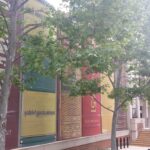
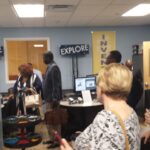

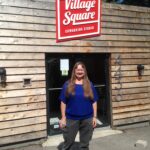





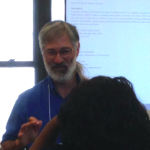
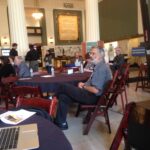
By Strengthening Partnerships - 06/27/2016 - Partners Bridging the Digital Divide June 24, 2016 - 11:47 am
[…] include broadband and community-based digital inclusion programs. NDIA’s sponsorship of the Net Inclusion Summit in May in Kansas City presented a tremendous opportunity for practitioners, librarians, and policy-makers to gather […]
By Strengthening Partnerships - 07/05/2016 - Partners Bridging the Digital Divide July 5, 2016 - 3:25 pm
[…] include broadband and community-based digital inclusion programs. NDIA’s sponsorship of the Net Inclusion Summit in May in Kansas City presented a tremendous opportunity for practitioners, librarians, and policy-makers to gather […]
By P2PU - Peer 2 Peer University - Partners Bridging the Digital Divide September 11, 2018 - 9:09 am
[…] since we learned about peer-to-peer learning circles at the June 2016 NDIA conference, we’ve discussed setting one up since P2PU provides great free material for running learning […]
By October 2018 Newsletter - Partners Bridging the Digital Divide October 3, 2018 - 4:16 pm
[…] since we learned about peer-to-peer learning circles at the June 2016 NDIA conference, we had discussed setting one up since P2PU provides great free material for running learning […]